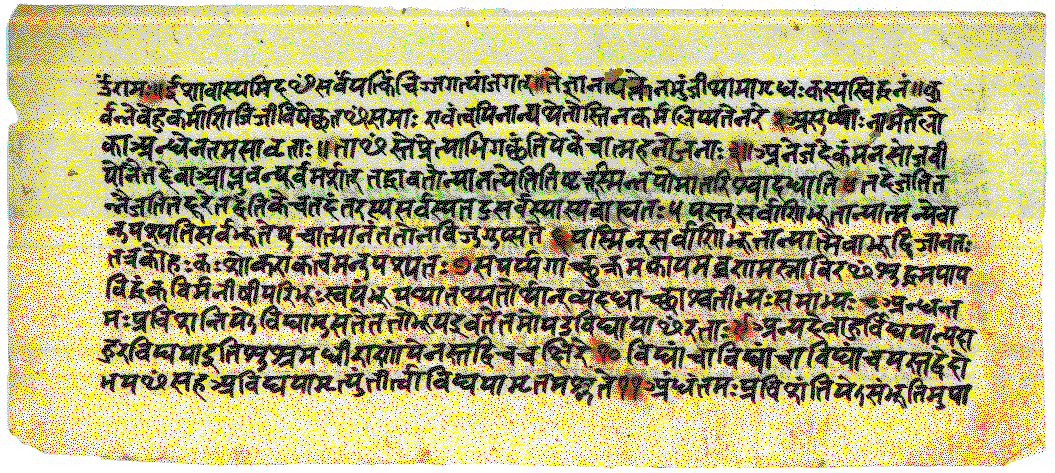Meditation According to Patānjali Yoga and Advaita Vedānta
According to Patānjali, yoga is defined as “stilling the modification of the Mind”: योग: चित्त-वृत्ति निरोध: (yogaḥ citta-vṛtti-nirodhaḥ): Yoga Sutras 1.2.
In Advaita Vedānta, Self-Knowledge (ātma-jñāna) refers to discrimination (viveka) between the Self, ātma, and the mind (citta) and to know their nature as they truly are (yathārtha-jñāna).
Let’s look at how the Bhagavad Gītā approaches this topic. The most definitive instructions are provided in chapter 6, verse 25, as follows:
शनैः शनैरुपरमेद्बुद्ध्या धृतिगृहीतया ।
आत्मसंस्थं मनः कृत्वा न किञ्चिदपि चिन्तयेत् ॥ २५ ॥ I
śanaiḥ śanairuparamedbuddhyā dhṛtigṛhītayā |
ātmasaṁsthaṁ manaḥ kṛtvā na kiñcidapi cintayet // BG 6.25
One should attain tranquility through gradual practice; establishing the mind in the Self through steadfast intellect, one should not think of anything else.
So, this is the long and short of meditation according to Vedānta: आत्मसंस्थं मनः कृत्वा: establishing the mind in the Self. This is Śaṅkara’s well-ascertained view on this verse:
आत्मसंस्थम् आत्मनि संस्थितम् ‘आत्मैव सर्वं न ततोऽन्यत् किञ्चिदस्ति’ इत्येवमात्मसंस्थं मनः कृत्वा न किञ्चिदपि चिन्तयेत् । एष योगस्य परमो विधिः ॥
ātmasaṁstham ātmani saṁsthitam ‘ātmaiva sarvaṁ na tato’nyat kiñcidasti’ ityevamātmasaṁsthaṁ manaḥ kṛtvā na kiñcidapi cintayet | eṣa yogasya paramo vidhiḥ || [Śaṅkara Bhāṣya on verse 6.25]
One should make the mind constantly abide in the Self, bearing in mind that the Self is all (सर्वं) and that nothing else exists. This* is the highest form of yoga. [Trans. Alladi M. Sastri, p. 196, emphasis added]
*Anandgiri’s gloss: “This” denotes “the steadiness of the mind (in the Self).”
Thus, the focus of Patānjali’s yoga is on controlling the changing states, the modifications or the vṛttis of the mind whereas Vedānta’s focus is on cognizing the unchanging Seer (Witnessing Principle).
This fundamental distinction should never be lost sight of. It is also important to remember that all meditative states (including the highest meditative absorption called nirvikalpa samādhi) are subject to appearance and disappearance; they come and go, āgamāpāyino’nityā (BG 2.14). Whereas the Self, ātma, is an ever-attained, nitya-prāpta-vastu, and does not come and go. This is also the basic difference between the Buddhist view of consciousness as momentary (ksanika) and Vedāntic understanding of eternal pure consciousness, nitya-shudha chaitanyam. Logically speaking, there has to be a conscious, changeless principle to register the changes. And that changeless principle is our true nature according to Advaita Vedānta.
From the foregoing, the following further corollaries can be deduced:
- Advaita Vedānta, or its goal (sādhya) the Self, is vastu-tantra (the science of cognizing the Reality, the vastu, as is). It does not depend upon the whims and fancies of the knower or the so called meditator.
- Meditation, as commonly understood and practiced, is kratru-tantra (a state or something to be “done” or “created” or “accomplished”)
- Put differently, cognizing/realizing the Self in Vedānta is a karaṇ-nirpekṣa-sādhan (independent of action and means of action) whereas Patānjali yoga and all forms of meditation are karna-sāpekṣa-sādhan—means that are dependent upon action for their accomplishment.
- Anything “created” can never be eternal. It will be subject to the laws and limitation of time and space and causality (desa-kāla-vastu-parichinna). Muṇḍaka Upaniṣad clearly states that “the eternal cannot be created through action”: nāstyakṛtaḥ kṛtena (1.2.12)
- My true nature (Self) has to be/is eternal and ever-attained. It is my very svarūpa, essential nature. It is direct and immediate, sākśāt-aprōksāt.
One has to listen to It from a teacher (gurur-mukhārvinda) who has realized It in his/her anubhava, direct experience. One-on-one, sitting at the feet of the guru. One cannot “get it” on one’s own, just by reading books or surfing on the internet, including FB. 🙂
How can the Self be found in the books or in meditation or outside?
It is apremayam (non-objectifiable). It is the very Subject. It is our true nature. Tat Tvam Asi. That YOU are.
In the next post, we will see how to “cognize” the Self in one’s own direct anubhava, like a gooseberry (āmlā) on one’s palm.
My teacher once explained about the simplicity of knowing the Self, thusly, “It is like going home. Why should it be complicated?” He then added, “But it is subtle. It requires सूक्ष्म बुद्धि sukshma-buddhi, subtle intellect, not so much sharp intellect, तीक्ष्ण बुद्धि teekshna-buddhi.”
Thus have I heard from those in the know…
To be continued…


Recent Comments